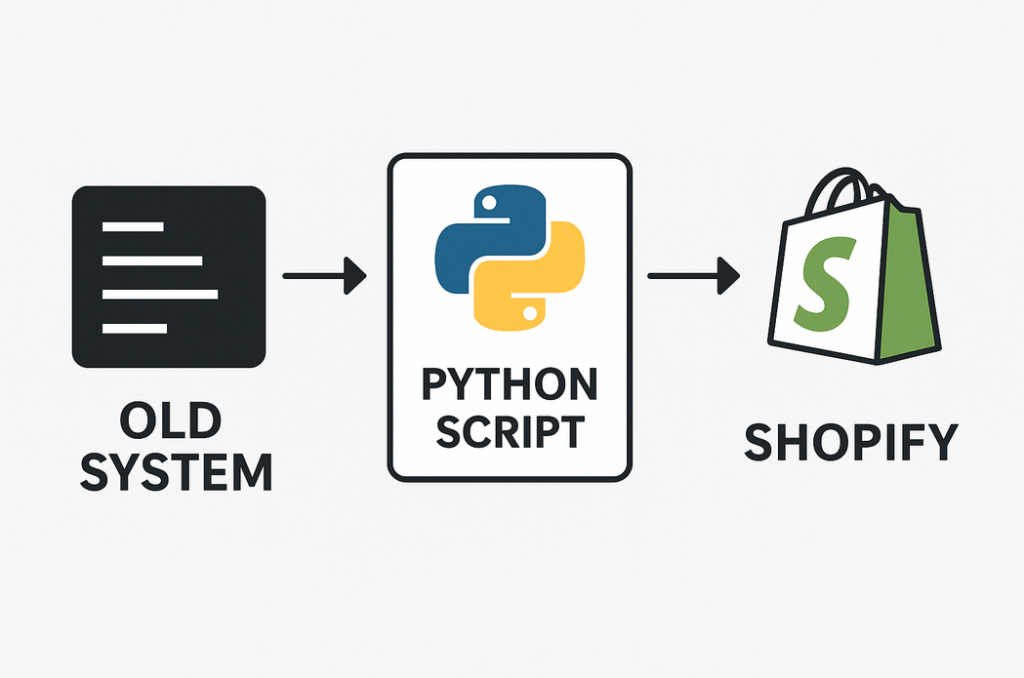Introduction: The Challenge of Migrating Thousands of Orders
Migrating eCommerce data can feel overwhelming—especially when you’re dealing with thousands of historical orders. When my client decided to move from BloomNation to Shopify, I was staring at 9,000+ customer orders that needed to be transferred. Doing this manually would have taken weeks, if not months, and left plenty of room for human error.
Instead, I took a different path: automation with Python.
What followed was a structured migration process that not only saved time but also gave me complete confidence that the data was moved accurately, with full logs, counts, and error recovery mechanisms. Here’s exactly how I did it.
Why Shopify Was the Right Choice
Before diving into the technical details, it’s important to explain why we chose Shopify. Shopify provided:
- Scalability for handling thousands of orders.
- Built-in analytics and reports that simplified our operations.
- Ease of management for non-technical staff after migration.
With these benefits in mind, moving to Shopify wasn’t just a technical project—it was a strategic business decision.
Read our last article for details here
Planning the Migration Strategy
Evaluating Existing Data Sources
I first reviewed the structure of our existing orders: customer info, products, payment details, shipping addresses, and timestamps. Making sure we plan for the data which need to be added in metafields.
Deciding on a Migration Approach
Options included:
- Manual export/import → not scalable.
- Third-party apps → costly and not flexible.
- Custom Python script → full control, cost-effective, reusable.
I chose the Python approach.
Risks of Manual Migration vs. Automation
Manual migration could cause data mismatches and endless repetitive work. Automation, while more complex upfront, reduced errors and provided repeatability.
Building a Python Script for Migration
Setting Up the Development Environment
I used:
- Python 3.10+
- Libraries like
requests,pandas, andcsv - Shopify API credentials for authentication
Designing the Script Logic
The script pulled records from our old database, which we had in a csv file, mapped them to Shopify’s API format, and pushed them in batches.
Logging and Monitoring Progress
I included detailed logs to record successes, failures, and API responses. This allowed me to track progress without guessing.
Handling Data Validation and Integrity
Ensuring Accuracy of Order Data
I validated:
- Customer emails
- Order totals
- Product SKUs
- Payment status
- Shipping and Delivery details
Dealing With Missing or Incomplete Records
Any order missing critical data was flagged, saved in a separate file, and reviewed manually before retrying. We faced issue in phone number field format.
Error Handling With CSV Backup Files
Saving Failed Records for Review
If an order failed during migration (due to bad data or API limits), the script wrote it into a failed_orders.csv file.
Retrying Failed Orders Efficiently
Instead of rerunning everything, I could just reload the failed CSV, fix the errors, and rerun the script. This was a huge time-saver.
Tracking Progress With Counts and Logs
Real-Time Monitoring
The script printed progress counts like:
- “500 orders migrated successfully”
- “25 failed orders saved to CSV”
Post-Migration Validation
After completion, I double-checked order counts in Shopify vs. the old system to ensure no records were missed.
Testing the Migration Before Going Live
Running Migration in Sandbox Mode
I first sent orders to a Shopify development store. This ensured the data looked correct before going live.
Spot-Checking Orders in Shopify
I manually reviewed customer histories, line items, and payment statuses to confirm accuracy.
Final Migration and Go-Live
Addressing Last-Minute Issues
A few API rate limits required throttling requests. Luckily, logs made this easy to diagnose.
Verifying Business Continuity
Customers were able to see their order history immediately after migration—no disruption to their experience.
Lessons Learned From Migrating 9,000+ Orders
- Logs are lifesavers—never skip them.
- Error handling is non-negotiable.
- Automation pays off—what seemed complex upfront saved me days of work.
Tools and Resources That Helped
- Shopify Admin API Documentation
- Python Pandas for data cleaning
- CSV exports for backups
FAQs About Shopify Order Migration
1. Can I migrate orders to Shopify without coding?
Yes—there are third-party tools, but they can be expensive. Coding gives you full control.
2. How long does it take to migrate thousands of orders?
With automation, I migrated 9,000+ orders in a few hours.
3. What if some orders fail during migration?
Use a backup system like CSVs to log failed records and retry later.
4. Is Python the best language for Shopify migration?
Python is flexible and works well with APIs, but you can use Node.js, Ruby, or PHP too.
5. Will customers lose their history during migration?
No—if orders are migrated correctly, customer histories remain intact.
6. Do I need a developer account on Shopify?
Yes, you need API credentials from a Shopify app for secure migration.
Conclusion: Why Automation Made All the Difference
Migrating 9,000+ orders to Shopify may sound intimidating, but with the right approach, it’s entirely manageable. My Python script, detailed logs, error handling with CSVs, and real-time counts made the process smooth, accurate, and stress-free.
If you’re planning a migration, don’t fear the scale—plan well, automate wisely, and validate everything.
